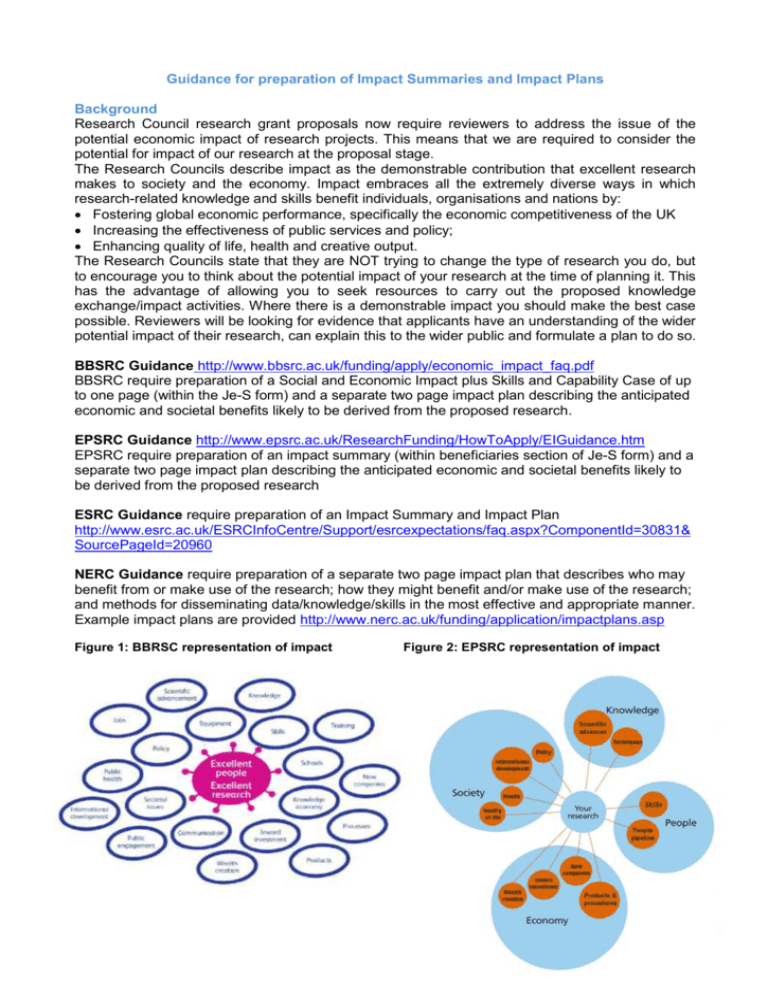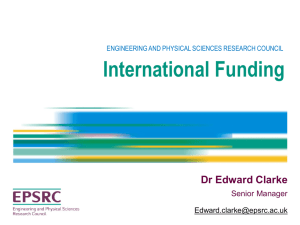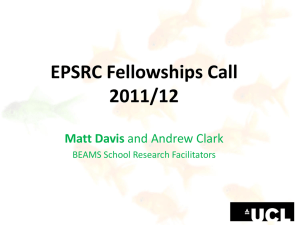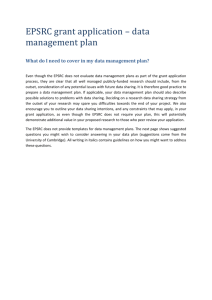Guidance for preparation of Impact Summaries and
advertisement

Guidance for preparation of Impact Summaries and Impact Plans Background Research Council research grant proposals now require reviewers to address the issue of the potential economic impact of research projects. This means that we are required to consider the potential for impact of our research at the proposal stage. The Research Councils describe impact as the demonstrable contribution that excellent research makes to society and the economy. Impact embraces all the extremely diverse ways in which research-related knowledge and skills benefit individuals, organisations and nations by: Fostering global economic performance, specifically the economic competitiveness of the UK Increasing the effectiveness of public services and policy; Enhancing quality of life, health and creative output. The Research Councils state that they are NOT trying to change the type of research you do, but to encourage you to think about the potential impact of your research at the time of planning it. This has the advantage of allowing you to seek resources to carry out the proposed knowledge exchange/impact activities. Where there is a demonstrable impact you should make the best case possible. Reviewers will be looking for evidence that applicants have an understanding of the wider potential impact of their research, can explain this to the wider public and formulate a plan to do so. BBSRC Guidance http://www.bbsrc.ac.uk/funding/apply/economic_impact_faq.pdf BBSRC require preparation of a Social and Economic Impact plus Skills and Capability Case of up to one page (within the Je-S form) and a separate two page impact plan describing the anticipated economic and societal benefits likely to be derived from the proposed research. EPSRC Guidance http://www.epsrc.ac.uk/ResearchFunding/HowToApply/EIGuidance.htm EPSRC require preparation of an impact summary (within beneficiaries section of Je-S form) and a separate two page impact plan describing the anticipated economic and societal benefits likely to be derived from the proposed research ESRC Guidance require preparation of an Impact Summary and Impact Plan http://www.esrc.ac.uk/ESRCInfoCentre/Support/esrcexpectations/faq.aspx?ComponentId=30831& SourcePageId=20960 NERC Guidance require preparation of a separate two page impact plan that describes who may benefit from or make use of the research; how they might benefit and/or make use of the research; and methods for disseminating data/knowledge/skills in the most effective and appropriate manner. Example impact plans are provided http://www.nerc.ac.uk/funding/application/impactplans.asp Figure 1: BBRSC representation of impact Figure 2: EPSRC representation of impact How to write the Impact Plan: Impact encompasses a wide range of benefits - including knowledge, skills and trained people, societal and economic benefits - and these can be realised over a wide variety of timescales. When writing this consider first what is reasonable and/or expected for research of this nature. It will help if you prepare the impact plan at the same time as planning your case for support and allow plenty of time and get feedback on drafts from colleagues/end user such as industrial partners. Ensure that any letters of support from partners explain the importance and impact of the research for their organisation and their role. Where the call for proposals requires inclusion of an exploitation plan, you can use your 2 page Impact Plan to expand on the exploitation plan. For all Research Councils the Impact Plan (up to two sides of A4) should address the three questions: 1. Who will benefit from this research? 2. How will they benefit from this research? (e.g. economic impact, policy, quality of life) 3. What will be done to ensure that they have the opportunity to benefit from this research? (e.g. activities to ensure engagement e.g. secondments, workshops, publications) and who will do this (students, specialised staff, technical experts and the cost of these activities) In the plan answer the three questions above and specifically address how the proposed research project will be managed to engage users and beneficiaries and increase the likelihood of impacts, including (wherever appropriate): a. Methods for communications and engagement b. Collaboration and exploitation in the most effective and appropriate manner c. Track record in this area d. The resources required for these activities. Please ensure these are also captured in the financial summary and the Justification of Resources. Please note: for EPSRC the Impact Plan is specific to users and beneficiaries of the research who are outside of the academic research community and the EPSRC Impact Summary section of the Je-S form is specific to academic beneficiaries. Suggested Template compiled using the checklist in Annex 2. 1. Proposal Title 2. Who will benefit from the proposed research? 3. How they will benefit, 4. Methods or activities with which you will communicate and engage with these groups 5. Track Record: provide details of previous projects in which you have been involved that have had significant impact or resulted in commercial exploitation. 6. Milestones and measures of success of your impact activities: Include ways you might measure the success of your impact activities e.g. any plans for commercialisation activities towards the end of the grant. 7. Summary of resources Ensure you cover everything allowable, including conference attendance, partner and project meetings, travel to stakeholder meetings, publication fees and consultancy costs (e.g. for publicity, media training etc) where appropriate. NOTE: Impact summaries and plans may be published so do not put in confidential information! Appendix 1: CHECKLIST Have you considered the following in your impact summary/plan? Considered 1. Who will benefit from this research? Industry Wider public Public sector/third sector (museums, schools) Government/policy makers (national, international) Academics 2. How will they benefit from this research? Define the potential impact on UK health, wealth and culture (e.g. economic competitiveness, public services, policy, quality of life, creativity) with timescales. Economic impact (examples could include): Spin-out companies: including the potential for creation of new jobs Processes/procedures Products/equipment Consultation Industry standards Codes of practice Involvement/set up of national resources/databases Inward investment Societal impact (examples could include): Policy (national/international) International development Training of skilled people to contribute to the knowledge economy (research staff, students) 3. What will be done to ensure that they have the opportunity to benefit from this research? How will the proposed research project be managed to engage users/beneficiaries and increase the likelihood of impacts? a. Consider methods for communications and engagement Communication via events (conferences, seminars to a target audience) Communication via workshops (for training, information dissemination) Communication via exchanges/secondments Communication via progress reports Communication via publications and publicity materials* Communication via websites or other interactive media* Communication via networks/ professional groupings Communication via media relations/public affairs (Please note: media training is available) Communication via Outreach programmes (Help available from Imperials Outreach Team) Engagement via management or advisory boards (provide details of this) Engagement via regular team meetings b. Consider collaboration and exploitation in the most effective and appropriate manner. Collaboration: with details of roles/responsibilities/formal agreements (also in letters of support) Exploitation: Where appropriate, provide details of the exploitation plan, the agreements in place and mechanisms for exploitation (including Imperial Innovations (**sample text below) c. Consider Track record in this area Provide details of who will be responsible for the activities (you, students, specialised staff), include previous projects that have had significant impact/ exploitation Industrial or end-user collaborations Spin-out companies Patents filed Licensed IP Past research students or PDRAs who are now working for industrial partners d. Consider the costs of these activities Conference, partner and project meeting attendance and travel Publications, consultancy, training costs *Please note: Communications/ Faculty Media Manager can provide assistance as appropriate. **Imperial Innovations, the AIM-listed technology transfer company spun out from Imperial College in 2006, will manage commercialisation of IP resulting from the project. Innovations’ staff provide support for IP protection, licensing and spin-out incubation in addition to finding venture capital investment. Innovations currently manages over 150 commercial agreements and has spun out over 60 companies based on Imperial College research. Please note: for this checklist to work it has been password protected. To unlock please use the word ‘impact’ Appendix 2: EPSRC REVIEW OF IMPACT PLANS EPSRC have reviewed 70 + Impact Plans that have come in so far and collated some common threads. General comments There is no evidence that people are refusing to prepare them. No evidence of Universities or Communities using ‘boiler plate’ text – i.e. the same text for each Impact Plan. First grants generally have a better standard impact plan than other proposals Also, things like Overseas Travel Grants, Visiting Fellowships and networks were generally better. There were a sizeable number of proposals where the plan was merely the summaries cut and pasted. The summaries are just that, short descriptions of the beneficiaries and potential impact, for the public domain. The plan needs to set out what the researchers are actually going to do and why. Plans need to be UP TO two pages. While some were appropriately one paragraph, others appeared to be expanded to fill the whole two pages without adding anything of consequence. Researchers can ask for the resources to carry out the plan – it didn’t seem that any of the proposals did this. There was a lack of thinking widely and imaginatively about the type of impact the research could have, and over what timescales. For instance, only a few projects made mention of the potential impact on the RA or student. For dissemination, applicants need to be specific about which journals and conferences would be appropriate to reach the potential beneficiaries and why. Many plans contained general statements about `the usual journals`. It wasn’t always clear for projects involving collaborators that they had been involved in developing the plan. Often there was a description of the problem but no good description of how the project/plan would address it and how the collaborators would help achieve impact. Programme-specific comments Maths: suitably short, and focused on academic impact via dissemination BUT no expansion in the plans for dissemination e.g. comments like `the usual journals` need to explain which journals and why? Physical Sciences: generally filling the full 2 sides, and rather general. Could be shorter and pithier and be more specific about what is actually going to be done. Also need to expand on dissemination routes. Not addressing the long term potential impacts - tending to focus short-term. Engineering: generally good, with collaborator involvement. See comments above about ensuring collaborators built in to the plan. ICT: Similar comments to Physical Sciences. Should be well-placed to write an impact plan effectively but as yet are not making the most of the opportunity. University perspectives We looked at the impact plans clustered by university to see if there were any trends or lessons, either good or bad. There were no obvious trends. We will continue to monitor this.




